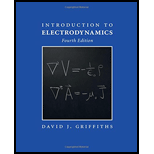
(a) Let
(b) Show that
Learn your wayIncludes step-by-step video

Chapter 1 Solutions
Introduction to Electrodynamics
Additional Science Textbook Solutions
Physics for Scientists and Engineers: A Strategic Approach with Modern Physics (4th Edition)
Cosmic Perspective Fundamentals
University Physics with Modern Physics (14th Edition)
Applied Physics (11th Edition)
The Cosmic Perspective Fundamentals (2nd Edition)
College Physics (10th Edition)
- X = 2ax(y³ + z³), Y= 2ay(y³ + z³) + 3ay²(x² +y²) , Z = 3az² (x² + y?) Examine whether the force field is conservative, and if conservative, find its potential.arrow_forward3. Given the following scalar potentials (V), calculate the solution for the gradient of V (VV), and plot the vector arrow representation of this vector field over the given limits. (a) V = 15 + r cos o, for 0 < r < 10, and 0 < $ < 2n. (b) V = 100 + xy, for –10 < x < 10,arrow_forwardA sphere of radius a has potential (sin 2θ)( cos ϕ) on its surface. Find the potential at all points outside the sphere.arrow_forward
- Consider the vector field F(x,y)=(4x^3y^2−2xy^3)i+(2x^4y−3x^2y^2+4y^3) a. Find the potential function f(x,y). b. Determine the work done by the vector field in moving a particle along a curve C from (1,2) to (3,1).arrow_forwardQ3/ a) given that the potential v = (2x²y + 2xy²z²)mv 1) Find E at (1,2,3) 2) Py c/m³ b) point p and Q are located at P(1,2,3) and Q(3,2,1) find the vector parallel to PQ with magnitude of 5cm.arrow_forwardIf V (x, y) is the electric potential at a point (x, y) of the xy plane, then the level curves of V are called equipotential curves, so that at all points on this curve the electric potential is the same. Find the range of V and the level curves of the following function:arrow_forward
- When two charges of the same sign and magnitude are at the adjacent vertices of a square, the electric potential at the center of the square is V. What is the electric force on the charge of the same magnitude and sign positioned at the center of the opposite side, at point P, in addition to the two original charges? Draw the electric force vectors and express your answer in term of V and k. □arrow_forwardConsider the following potential V(x) = 3x2 + 4.x + 3. The equilibrium and it is a position is located at equilibriumarrow_forward247. Consider a particle moving in the region x> 0 under the influence of the potential a + а, U(x) %3D where U, = 1 J and a = 2 m. Plot the potential, find the equilibrium points, and determine whether they are maxima or minima.arrow_forward
- Consider the vector field T(x) = y³î – x³j. Which of the following expressions is a vector potential for v(x) ? Select one: a. there is no vector potential since V x u + 0 b. There is no vector potential since V · U = 0 %D c. 3(x2 + y²)k d. –3(x? + y²)k e. none of the other answers is correct. O f.-zx'j + x*k 1 4arrow_forwardUsing the general expression V(r,0) E (A,r BỊ + 1) P(cose) for the potential at a distance r from the center of a sphere shell of radius R. The acceptable expressions for potentials inside and outside the shell are: V (r,0) : E, Ar' P,(cose) (rarrow_forwardShow that if the potential energy expression is always positive for arbitrary 5, and 2, which do not vanish simultaneously, it is necessary that C11> 0 and C11C22 > C12²2 Hint. V = [(√₁³₁ ± √₂₂d₂)² = 2(√C₁1C₂2 - C₁2)818₂] V > 0 for d₁ = 0 V >0 for d₂ = 0 V > 0 for √₁0₁ ± √2202 = 0arrow_forwardarrow_back_iosSEE MORE QUESTIONSarrow_forward_ios
 Classical Dynamics of Particles and SystemsPhysicsISBN:9780534408961Author:Stephen T. Thornton, Jerry B. MarionPublisher:Cengage Learning
Classical Dynamics of Particles and SystemsPhysicsISBN:9780534408961Author:Stephen T. Thornton, Jerry B. MarionPublisher:Cengage Learning
